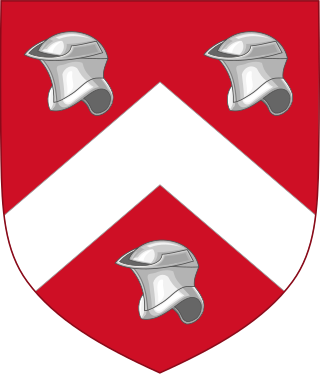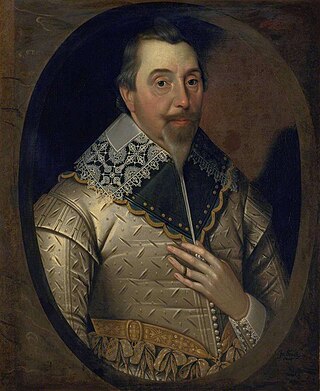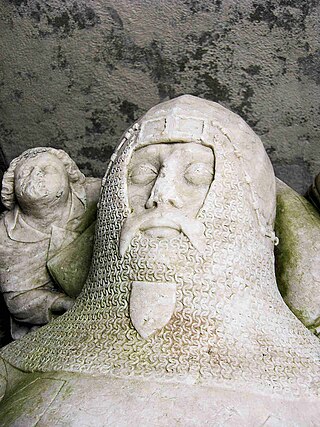Related Research Articles

Sir Owen Tudor was a Welsh courtier and the second husband of Queen Catherine of Valois (1401–1437), widow of King Henry V of England. He was the grandfather of Henry VII, founder of the Tudor dynasty.

Penmynydd, meaning "top of the mountain" in Welsh, is a village and community on Anglesey, Wales. It is known for being the birthplace of the Tudors of Penmynydd, which became the House of Tudor. The population according to the United Kingdom Census 2011 was 465. The community includes the village of Star.
Ednyfed Fychan, full name Ednyfed Fychan ap Cynwrig, was a Welsh warrior who became Seneschal to the Kingdom of Gwynedd in Northern Wales, serving Llywelyn the Great and his son Dafydd ap Llywelyn. Ednyfed claimed descent from Marchudd ap Cynan, Lord of Rhos, 'protector' of Rhodri Mawr, King of Gwynedd. He was the patrilineal ancestor of Owen Tudor and thereby of the Tudor dynasty.

Gruffudd Fychan II was Lord of Glyndyfrdwy and Lord of Cynllaith Owain c.1330–1369. As such, he had a claim to be hereditary Prince of Powys Fadog, and was a member of the Royal House of Mathrafal. His son, Owain Glyndwr, started the Welsh Revolt and became Prince of Wales.

Robert Puleston was a brother-in-law and supporter of Owain Glyndŵr, at the time of his rebellion against King Henry IV of England in the early 15th century and afterwards.

The Glyndŵr rebellion was a Welsh rebellion led by Owain Glyndŵr against the Kingdom of England during the Late Middle Ages. During the rebellion's height between 1403 and 1406, Owain exercised control over the majority of Wales after capturing several of the most powerful English castles in the country, and formed a national parliament at Machynlleth. The revolt was the last major manifestation of a Welsh independence before the annexation of Wales into England in 1543.
Tudur, from old Welsh Tutir, is the Welsh form of the given name Theodoric and may refer to:

The Royal House of Mathrafal began as a cadet branch of the Welsh Royal House of Dinefwr, taking their name from Mathrafal Castle. They effectively replaced the House of Gwertherion, who had been ruling the Kingdom of Powys since late Roman Britain, through the politically advantageous marriage of an ancestor, Merfyn the Oppressor. King Bleddyn ap Cynfyn would join the resistance of the Anglo-Saxon King Harold Godwinson, against the invasion of William the Conqueror, following the Norman conquest of England. Thereafter, they would struggle with the Plantagenets and the remaining Welsh Royal houses for the control of Wales. Although their fortunes rose and fell over the generations, they are primarily remembered as Kings of Powys and last native Prince of Wales.

Tudur ap Gruffudd (1365–1405), also known as Tudor de Glendore or Tudor Glendower, was the Lord of Gwyddelwern, a junior title of the princely house of Powys Fadog, and was the younger brother of Owain Glyndŵr, the Welsh rebel leader crowned Prince of Wales. His father was Gruffydd Fychan II, the hereditary Prince of Powys Fadog and previous Lord of Gwyddelwern. Along with his brother, Owain Glyndŵr, Tudur was a member of the royal House of Mathrafal.
Angharad ferch Llywelyn was a daughter of Llywelyn ab Iorwerth, Prince of Wales. The identity of her mother is uncertain; but several later genealogical sources, including Pedigrees of Some Of the Emperor Charlemagne's Descendants, Volume III, compiled by J. Orton Buck and Timothy Field Beard, give Llywelyn's consort Joan, daughter of King John of England, as her mother.
Maredudd ap Tudur was a Welsh soldier and nobleman from the Tudor family of Penmynydd. He was the youngest of six sons of Tudur ap Goronwy and was the father of Owen Tudor. Maredudd supported his cousin the Welsh patriot Owain Glyndŵr in 1400, alongside his brothers Rhys ap Tudur and Gwilym ap Tudur.

The Tudors of Penmynydd were a noble and aristocratic family, connected with the village of Penmynydd in Anglesey, North Wales, who were very influential in Welsh politics. From this family arose Sir Owen Tudor and thereby the Tudor dynasty, that ruled the Kingdom of England from 1485 to 1603. The Tudor dynasty ended in the early 17th century with the death of Elizabeth I.

Goronwy ap Tudur Hen, also known as Goronwy ap Tudur or Goronwy Fychan, was a Welsh aristocrat and Lord of Penmynydd. He was a member of the Tudor family of Penmynydd, Anglesey, North Wales, and a direct ancestor of Owen Tudor and thereby the Royal House of Tudor. He was a soldier for the English crown, who fought in the First War of Scottish Independence, including in the English invasion which led to the Battle of Bannockburn. He remained loyal to King Edward II of England until the king's death, and was both a yeoman and forester of Snowdon. After his death in 1331, his body was interred in Llanfaes Friary, near Bangor, Gwynedd.

Tudur ap Goronwy was a Welsh landowner, soldier and administrator of the Tudors of Penmynydd family from the island of Anglesey.
Tudur Hen or Tudur ap Goronwy was a Welsh aristocrat and original founder of the House of Tudor. He was one of three sons of Goronwy ab Ednyfed who received lands from King Edward I of England. Nonetheless, he backed the rebellion of Madog ap Llywelyn, but afterwards swore allegiance to both Edward I and his son, Edward of Caernarfon. Tudur Hen was responsible for the restoration of the Franciscan friary at Bangor, where his body was later placed on 11 October 1311.
Goronwy ab Ednyfed was seneschal to Llywelyn ap Gruffudd, king of Gwynedd. Goronwy was the founder of the Tudor family of Penmynydd.

Carreglwyd is a Georgian country house, on the northwest of the Isle of Anglesey, about 1 km NW of Llanfaethlu in Wales, at grid reference SH309878.
Gwilym ap Tudur was a Welsh nobleman and a member of the Tudor family of Penmynydd. In 1401, he and his brother Rhys ap Tudur took Conwy Castle after infiltrating it, in support of their cousin Owain Glyndŵr. Gwilym was subsequently pardoned in 1413, following the execution of his brother a year earlier.
Gwilym ap Griffith, also known as Gwilym ap Gruffydd, was a Welsh landowner. He briefly lent his support to Owain Glyndŵr in the Glyndŵr Rising. When his loyalty returned to the Crown, he was granted the lands of number of Glyndŵr supporters and by the end of his life had ownership of the majority of the lands previously held by the Tudors of Penmynydd.
William Griffith (1480–1545) of Penrhyn Castle was a Welsh politician. He was knighted at Touraine in 1513 and was Chamberlain of North Wales in 1520. He was with Henry VIII of England at the Sieges of Boulogne (1544–46).
References
- Griffiths, Ralph Alan; Thomas, Roger S. (1985). The Making of the Tudor Dynasty . New York: St. Martin's Press. ISBN 978-0-31250-745-9.
- Nicholas, Thomas (1872). Annals and Antiquities of the Counties and County Families of Wales. Vol. 1. London: Genealogical Publishing.
- Roberts, Glyn (1959). "Ednyfed Fychan". Dictionary of Welsh Biography . National Library of Wales . Retrieved 17 June 2016.